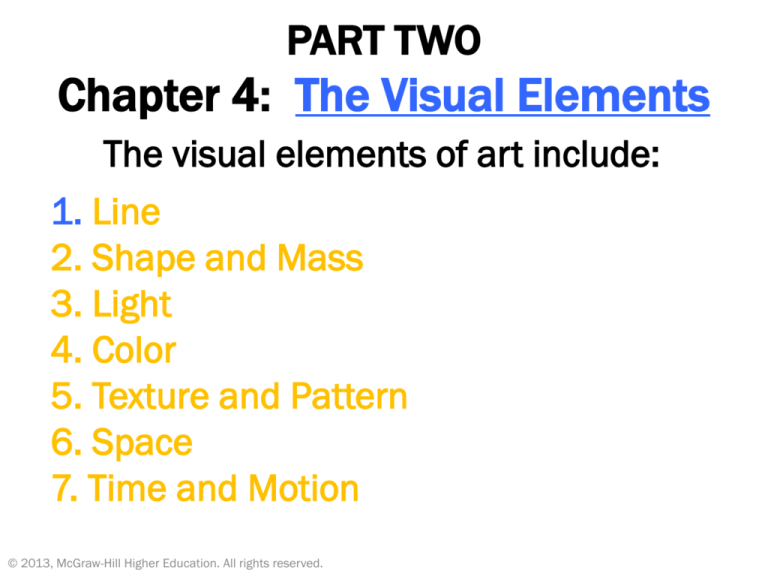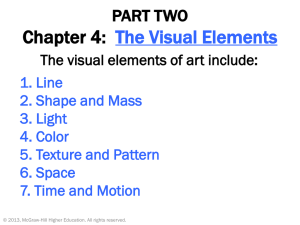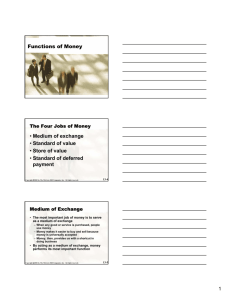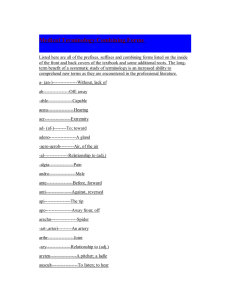
PART TWO
Chapter 4: The Visual Elements
The visual elements of art include:
1. Line
2. Shape and Mass
3. Light
4. Color
5. Texture and Pattern
6. Space
7. Time and Motion
© 2013, McGraw-Hill Higher Education. All rights reserved.
Key Terms for this chapter include:
• Line: contour, outline
• Shape and Mass: geometric/organic shapes,
figure/ground, positive/negative shapes
• Light: value, modeling, chiaroscuro, stippling, hatching,
cross-hatching
• Color: reflected/refracted light, hue, value, intensity,
tint, shade, monochromatic, complementary,
analogous, triadic, simultaneous contrast, afterimage,
pointillism
• Texture and Pattern: actual/visual texture
• Space: picture plane, perspective (linear, 1-point, 2point, atmosphere, isometric), foreshortening
• Time and Motion: kinetic art
© 2013, McGraw-Hill Higher Education. All rights reserved.
The Visual Elements
The visual elements help us analyze
our visual experiences. These 7
terms are also used as the
fundamental language for the
discussion about works of art.
© 2013, McGraw-Hill Higher Education. All rights reserved.
LINE: Contour and Outline
Line is defined as the path of moving
point.
• Outline: Defines a 2-dimensional shape.
• Contour lines: Record boundaries and
define more specifically what shapes
represent.
Insert visual(s).
Suggestion: 4.4 Sequence 6 from
Flow Chart for “The Perfect Ride”
© 2013, McGraw-Hill Higher Education. All rights reserved.
Sequence 6 from Flow Chart of the “Perfect Ride”
Animation, Jennifer Pastor, 2000
LINE: Direction and Movement
Artists use line to direct and move
our eyes around a work of art.
• Vertical lines seem assertive, or denote
growth & strength.
• Horizontal lines appear calm.
• Diagonal lines are the most dramatic
and imply action.
Insert visual(s).
Suggestions:
4.7 Linear Analysis of The Biglin Brothers Racing
4.9 Linear Analysis of The Raft of Medusa
© 2013, McGraw-Hill Higher Education. All rights reserved.
The Biglin Brothers Racing,
Thomas Eakins, 1873-4
The Raft of the Medusa, Theodore Gericault,
1818-19 – 2 points of conflict
LINE: Implied Lines
Dotted lines and directional cues
such as a finger pointing in a specific
direction creating a line of sight are
examples of implied lines in action.
Insert visual(s).
Suggestion: 4.11 Linear Analysis of
The Embarkation for Cythera
© 2013, McGraw-Hill Higher Education. All rights reserved.
The Embarkation for Cythera, Jean-Antoine Watteau, 1718-19
SHAPE and MASS
Shape and mass can be created by line,
texture and color change.
• Shape: 2-dimensional form that occupies an
area with identifiable boundaries.
• Mass: 3-dimensional form that occupies a
volume of space with identifiable boundaries.
Insert visual(s).
Suggestions:
4.12 The Raven and the First Men
4.13 Chanter
© 2013, McGraw-Hill Higher Education. All rights reserved.
The Raven and the First Men, Bill
Reid, 1980.6’2”
Chanter, Emmi Whitehorse,
1991
SHAPE and MASS
The 2 broad categories of shapes
and masses are geometric and
organic.
• Geometric forms can be mathematically
defined.
• Organic forms are irregular and suggest
forms found in nature.
Insert visual(s).
Suggestion: 4.14 circular shield with
stepped fret design
© 2013, McGraw-Hill Higher Education. All rights reserved.
Circular shield with stepped fret
design, Aztec, 1521
SHAPE and MASS
The figure and the ground are how
we perceive shapes and masses
within a work of art.
• Figure: the positive shape on which
visual focus is placed.
• Ground: the negative shape or area
sometimes considered the background
of a work of art.
© 2013, McGraw-Hill Higher Education. All rights reserved.
SHAPE and MASS
Artists use implied shapes to help
unify their compositions. Implied
shapes can help to create a sense
of order in a work of art.
© 2013, McGraw-Hill Higher Education. All rights reserved.
The Madonna of the Meadows, Raphael, 1505 – Implied line
LIGHT
The fundamental purpose of light is
to show us the material world. It
helps us understand forms and
spatial relationships.
© 2013, McGraw-Hill Higher Education. All rights reserved.
DW 68 VEN MCASD 11, Doug Wheeler, Installation,
1968/2011
LIGHT
Both actual and illusionistic light are
used and are important for artwork.
• Actual light: existing light either natural
or man-made.
• Illusionistic light: the impression of light
created by the artist.
© 2013, McGraw-Hill Higher Education. All rights reserved.
LIGHT: Implied
There are several value techniques that
artists use to imply light within works of art.
These techniques result in the illusion of
shape and mass of objects.
• Shading/Modeling: Using chiaroscuro or
values to create mass.
• Value: Relative lightness or darkness.
• Chiaroscuro: Italian for light/dark; contrasts of
light and shadow.
© 2013, McGraw-Hill Higher Education. All rights reserved.
LIGHT: Implied
There are several value techniques that
artists use to imply light within works of art.
These techniques result in the illusion of
shape and mass of objects.
• Hatching: Closely spaced parallel lines.
• Cross-hatching: Parallel lines intersect like a checkerboard.
• Stippling: Dots spaced close or far apart to suggest darker or
lighter areas.
© 2013, McGraw-Hill Higher Education. All rights reserved.
Implied Light
Untitled, Charles White, 1979
The Virgin and Saint Anne with the
Christ Child and John the Baptist,
Leonardo da Vinci,
COLOR: Color Theory
Color Wheel: Based on the refracted colors
observed by Sir Isaac Newton when light was
directed through a prism.
Primary Colors:
Yellow, Red, Blue
Secondary Colors:
Orange, Green, Violet
Intermediate Colors (total of 6):
Also called tertiary; Mix a
primary and adjacent
secondary together
© 2013, McGraw-Hill Higher Education. All rights reserved.
Color Wheel
COLOR: Color Properties
Hue: Name of the color
Value: Relative lightness or darkness
Intensity: (Chroma, Saturation)
Relative purity of a color
Color, Value, and Intensity
© 2013, McGraw-Hill Higher Education. All rights reserved.
COLOR: Color Properties
• Warm colors: located on
red-orange side of the
color wheel
• Cool colors: located on the
blue-green side of the
color wheel.
• Tint: adding white to a
pigmented color.
• Shade: adding black to a
color
© 2013, McGraw-Hill Higher Education. All rights reserved.
Color Wheel
COLOR: Light and Pigment
• Additive Color: Colors of light mixed
to produce still lighter colors.
Light primaries and their additive mixtures
© 2013, McGraw-Hill Higher Education. All rights reserved.
COLOR: Light and Pigment
• Subtractive Color: Pigments of
different hues mixed together result in
darker and duller colors.
Pigment primaries and their subtractive mixtures.
© 2013, McGraw-Hill Higher Education. All rights reserved.
COLOR: Color Harmonies
A color scheme is the selective use of 2
or more colors in a single composition.
• Monochromatic: Variations of the same hue.
• Complementary: Hues directly opposite on the
color wheel.
• Analogous: Adjacent hues on the color wheel.
• Triadic: 3 equidistant hues on the color wheel.
© 2013, McGraw-Hill Higher Education. All rights reserved.
COLOR: Optical Effects
• Simultaneous contrast: also called an
afterimage.
Complementary color afterimage
© 2013, McGraw-Hill Higher Education. All rights reserved.
COLOR: Optical Effects
• Pointillism: A technique of applying
dots of pure color that are then mixed
by our eyes to produce the illusion of
color mixtures.
• Optical Color Mixture: Color that is
mixed by the eyes.
© 2013, McGraw-Hill Higher Education. All rights reserved.
Evening, Honfleur, Georges Seurat,
1886
Hendrix, Devorah Sperber, 2009
The Scream, Edward Munch,
1893
• I sensed a shriek
passing through
nature --- I painted
this picture. I
painted the clouds
as actual blood.
TEXTURE and PATTERN
Texture and pattern are the perceived
surface qualities of a work of art. They can
be actual or implied.
• Actual texture: A tactile experience.
• Implied texture: An illusionary experience.
• Pattern: Any decorative, repetitive motif or
design.
© 2013, McGraw-Hill Higher Education. All rights reserved.
The Chief: He WhoSold Africa to the Colonists,
Samuel Fosso, 1997
Prayer Mat, Mona Hatourn, 1995
SPACE
Space interacts with other visual
elements and helps give them
definition. There exists both negative
and positive space.
Three dimensional space has height,
width, and depth.
© 2013, McGraw-Hill Higher Education. All rights reserved.
3d space
• Nose, Alberto
Giacommeti, 1947
• Inspired by dying
friend’s frail and
hollow face
Reflection, Do Ho Suh, 2004
SPACE: Implied and Illusionistic
Two dimensional space has only height and
width. There exists the picture plane and
the illusion of the negative (ground) and
positive (figure) space.
Implied Space: Includes overlapping and
position (foreground, middle-ground,
background)
Illusionistic Space: Includes foreshortening,
linear, isometric, and atmospheric perspective
© 2013, McGraw-Hill Higher Education. All rights reserved.
SPACE: Illusionistic
Linear Perspective
Basic principles of linear perspective
© 2013, McGraw-Hill Higher Education. All rights reserved.
The Last Supper, Leonardo da Vinci, 1495-97
SPACE: Illusionistic
Isometric Perspective
Basic principles of isometric perspective
© 2013, McGraw-Hill Higher Education. All rights reserved.
The Rocky Mountains, Landers Peak, Albert
Bierstadt, 1863- atmospheric perspective
SPACE: Illusionistic
• Foreshortening: The affect of linear
perspective when applied to objects and
human forms within a work of art.
• Atmospheric Perspective: As objects
recede into the distance they become
paler, bluer, and less distinct.
© 2013, McGraw-Hill Higher Education. All rights reserved.
The Groom and the Witch,
Hans Baldung Grien,
1540
FORESHORTENING
Draftsman Drawing a Reclining Nude, Albrecht Durer, 1527
TIME and MOTION
Time and motion have become
increasingly important to art during the
20th and 21st centuries. There is more
thought and emphasis placed on the
nature of time in our modern world.
Kinetic art: Art that actually moves.
© 2013, McGraw-Hill Higher Education. All rights reserved.
Southern Cross, Alexander
Calder, 1963
Bellamy, Richard Serra, 2001
Soundsuit, Nick Cave, 2011
Performance art, made to be worn,
costume for dance. First soundsuit
made as response to brutal beating
of Rodney King in early 1990s. Based
on notion that “black man is
discarded, devalued, etc. Chose
discarded objects to create a costume
that made one stand erect and want
to dance. Identity/race was hidden.
The Visual Elements: Summary
The Visual Elements and Key Terms:
• Line: contour, outline
• Shape and Mass: geometric/organic shapes,
figure/ground, positive/negative shapes
• Light: value, modeling, chiaroscuro, stippling, hatching,
cross-hatching
• Color: reflected/refracted light, palette, hue, value, and
intensity, monochromatic, complementary, analogous,
triadic, simultaneous contrast, afterimage, pointillism
• Texture and Pattern: actual/visual texture
• Space: picture plane, perspective (linear, 1-point, 2point, atmosphere, isometric), foreshortening
• Time and Motion: kinetic art
© 2013, McGraw-Hill Higher Education. All rights reserved.








